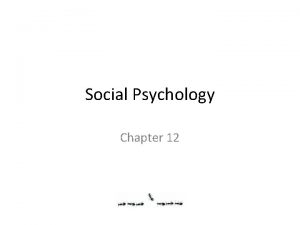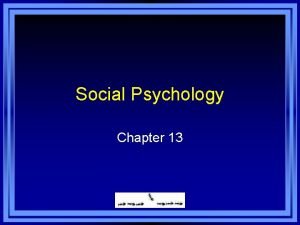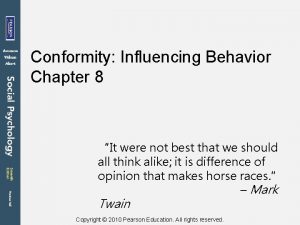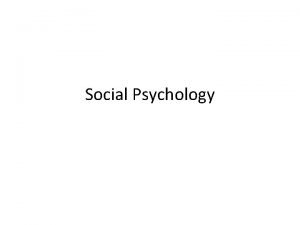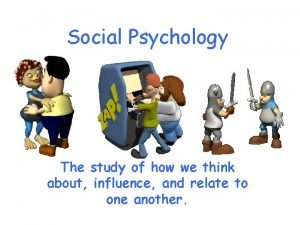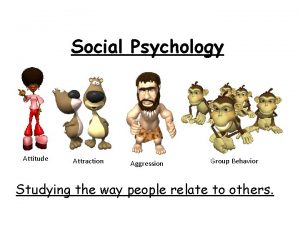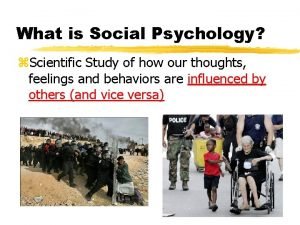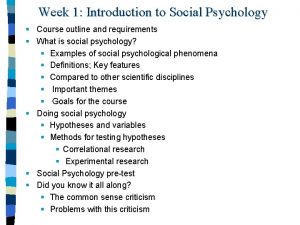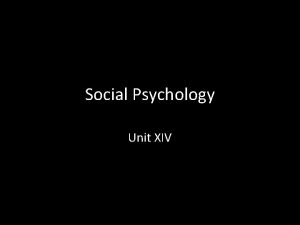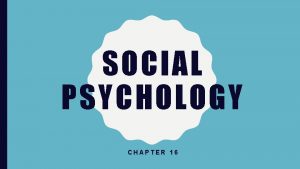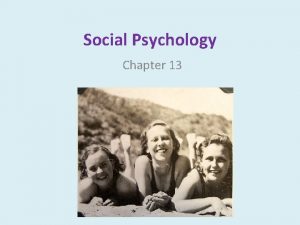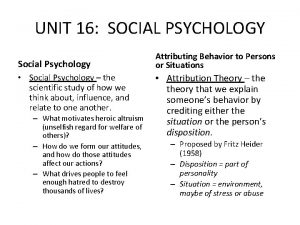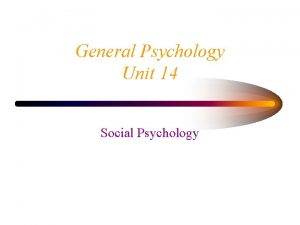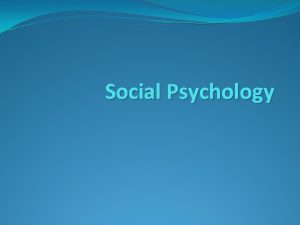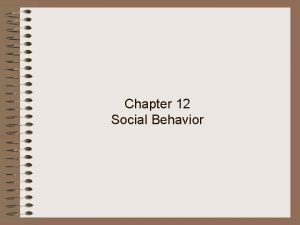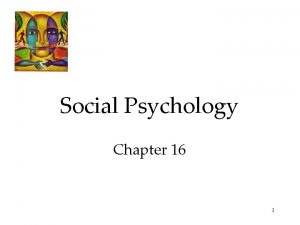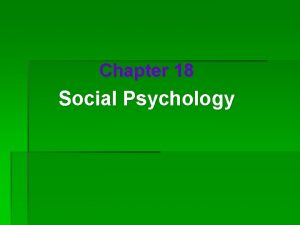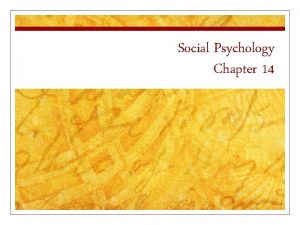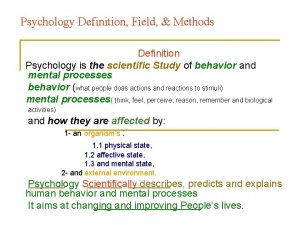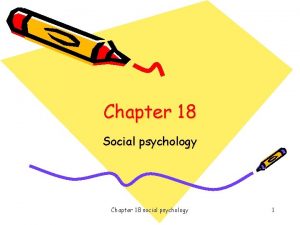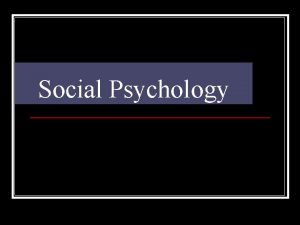Chapter 18 Social Psychology Definition of Social Psychology

























- Slides: 25

Chapter 18 Social Psychology

Definition of Social Psychology • Social Psychology – scientific study of how we think about, influence, and relate to and interact with one another – Psychologists study • Attractions • Needs • Influences (Group, gender, race, ethnicity) – Examine within social context of situations

Attitude formation and change • Attitude: learned predispositions to respond in a favorable or unfavorable way to a specific object, person, or event • Psychologists study how we develop our attitudes and how we can change attitudes • Formation of attitude – Personal experience – Secondhand attitudes – Mere exposure effect

Changing Attitudes: Persuasion • central route of persuasion: when people think carefully and critically about the contents of a message, they take a central route to persuasion and are influenced by the strength and quality of the arguments. • peripheral route to persuasion: when people do not think critically about the contents of a message and are influenced by superficial cues, they take a peripheral route to persuasion

Behavior=Attitude and Social Influences • Our behavior is affected by our inner attitudes as well as by external social influences Internal attitudes External influences Behavior






How do we tend to explain behavior? Attribution Theory – In thinking about others’ behavior and its causes, we tend to give a causal explanation for someone’s behavior, often by crediting either the situation or the person’s disposition – Simply put, we try to explain why someone does something – We are all prone to certain types of biases and distortions in judgment

The Effects of Attribution • How we explain someone’s behavior affects how we react to it Situational attribution “Maybe that driver is ill. ” Tolerant reaction (proceed cautiously, allow driver a wide berth) Dispositional attribution “Crazy driver!” Unfavorable reaction (speed up and race past the other driver, give a dirty look) Negative behavior

Thinking About Behavior • Fundamental Attribution Error – tendency for observers, when analyzing another’s behavior, to underestimate the impact of the situation and to overestimate the impact of personal disposition • Actor Observer bias – actors tend to attribute their own behavior to their circumstances (i. e. , situation causes) and the behaviors of those we observe to their dispositions – Self Serving Bias: – Tend to attribute we attribute our achievements and successes to personal, stable causes and our failures to situational factors – Self Handicapping – Handicap our own performance in order to build an excuse for anticipated failure

Attitude and Behavior • Cognitive Dissonance Theory – we act to reduce the discomfort (dissonance) we feel when our thoughts (cognitions) are inconsistent with our actions by changing our attitudes – Rating monotonous tasks

Social Roles and Social Norms • Every culture has – Social roles – expectations of behavior – Social norms – standards for behavior in given situations

• Violating a social norm video example

Social Influence: Conformity and Obedience • Conformity – adjusting one’s behavior or thinking to coincide with a group standard

Reasons For Conforming • Normative Social Influence -influence resulting from a person’s desire to gain approval or avoid disapproval • Informational Social Influence – when we do not know how to behave, we copy other people.

Social Influence: Compliance Strategies • Asch’s conformity experiments

Elevator clip

Obedience • The act of obeying, following directions – Milgram’s Obedience Study – Sheep, not wolves

Social Influence • Milgram’s follow-up obedience experiment Percentage of subjects who obeyed experimenter 100 90 80 70 60 50 40 30 20 10 0 The majority of subjects continued to obey to the end Very Extreme Moderate XXX Slight (75 -120) Strong strong Intense intensity Danger (435 -450) (15 -60) (135 -180) (195 -240) (255 -300) (315 -360) severe (375 -420) Shock levels in volts

What to remember • Social influences can be strong enough to make people conform to falsehoods or cruelty • Evil doesn’t require evil people, just ordinary people corrupted by an evil. • By understanding the process that shape this behavior, we may be less susceptible to pressures that might make us violate our own internal standards.

Conformity and Obedience • Zimbardo’s prison study – – Power of social roles influencing behaviors – Behavior changes to fit perceptions of role – Obedience in group situation

Group Project: Norm Violation Experiment Go out there and break the norm!
 Social trap
Social trap Social psychology is the scientific study of:
Social psychology is the scientific study of: Social psychology ap psychology
Social psychology ap psychology Positive psychology ap psychology definition
Positive psychology ap psychology definition Health psychology definition ap psychology
Health psychology definition ap psychology Social thinking and social influence in psychology
Social thinking and social influence in psychology Social thinking and social influence
Social thinking and social influence Chapter 12 social psychology
Chapter 12 social psychology Chapter 13 social psychology
Chapter 13 social psychology Ap psychology unit 14
Ap psychology unit 14 Application of psychology
Application of psychology Normative social influence
Normative social influence Pluralistic ignorance
Pluralistic ignorance Evaluation apprehension definition
Evaluation apprehension definition What is informational social influence in psychology
What is informational social influence in psychology Social trap
Social trap Bowlby monotropy
Bowlby monotropy Ap psychology unit 14 review
Ap psychology unit 14 review What is social psychology
What is social psychology Social psychology examples
Social psychology examples Social facilitation
Social facilitation Social thinking social influence social relations
Social thinking social influence social relations History and origin of science of psychology slideshare
History and origin of science of psychology slideshare Social inhibition example
Social inhibition example Social psychology course outline
Social psychology course outline Unit xiv social psychology
Unit xiv social psychology







